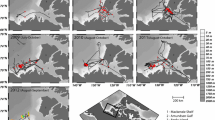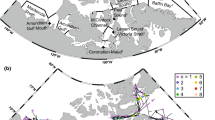Abstract
During the Circumpolar Flaw Lead System Study (CFL, 2007–2008), large aggregations of polar cod were detected in winter in the Amundsen Gulf (Western Canadian Arctic) using the EK60 echosounder of the CCGS Amundsen research icebreaker. Biomass estimated over 10 months reached a maximum of 0.732 kg m−2 in February. Aggregations were encountered only in the presence of an ice cover from December to April. The vertical extent of the aggregations was dictated by temperature and zooplankton prey distribution. In winter, polar cod generally occupied the relatively warm deep Atlantic Layer (>0°C), but a fraction of the densest aggregations occasionally followed zooplankton prey up into the cold Pacific Halocline (−1.6 to 0°C). The diel vertical migration of polar cod was precisely synchronized with the seasonally increasing photoperiod. Throughout winter, polar cod aggregations migrated to progressively deeper regions (from 220 to 550 m bottom depths) in response to increasing light intensity, presumably to avoid predation by visual predators such as the ringed seal. Comparing Amundsen Gulf and Franklin Bay indicates that the entrapment of polar cod in embayments during winter is an important mechanism to provide marine mammal predators with dense concentrations of their main prey within their diving range.









Similar content being viewed by others
References
Aagaard K (1984) The Beaufort undercurrent. In: Barnes PW, Schell DM, Reimnitz E (eds) The Alaskan beaufort sea: ecosystems and environments. Academic Press Inc, New York, pp 47–71
Baranenkova AS, Ponomarenko VP, Khokhlina NS (1966) The distribution, size and growth of the larvae and fry of Boreogadus saida (Lep.) in the Barents Sea. Vopr Ikhtiol 6:498–518. (Fish Mar Serv Transl Ser, No. 4025, 1977, 39 pp)
Barber DG, Hanesiak JM (2004) Meteorological forcing of sea ice concentrations in the Southern Beaufort Sea over the period 1979 to 2000. J Geophys Res 109:C06014
Barber DG, Asplin MG, Gratton Y, Lukovich JV, Galley RJ, Raddatz RL, Leitch D (2010) The international polar year (IPY) circumpolar flaw lead (CFL) system study: overview and the physical system. Atmos Ocean 48:225–243
Benoit D, Simard Y, Fortier L (2008) Hydroacoustic detection of large winter aggregations of Arctic cod (Boreogadus saida) at depth in ice-covered Franklin Bay (Beaufort Sea). J Geophys Res Ocean 113:C06S90
Benoit D, Simard Y, Gagné J, Geoffroy M, Fortier L (2010) From polar night to midnight sun: photoperiod, seal predation, and the diel vertical migrations of polar cod (Boreogadus saida) under landfast ice in the Arctic Ocean. Polar Biol 33:1505–1520
Born EW, Teilmann J, Acquarone M, Riget FF (2004) Habitat use of ringed seals (Phoca hispida) in the North Water area (North Baffin Bay). Arctic 57:129–142
Bouchard C, Fortier L (2008) Effects of polynyas on the hatching season, early growth and survival of polar cod Boreogadus saida in the Laptev Sea. Mar Ecol Prog Ser 355:247–256
Bouchard C, Fortier L (2011) Circum-arctic comparison of the hatching season of polar cod (Boreogadus saida): a test of the freshwater winter refuge hypothesis. Prog Oceanogr. doi:10.1016/j.pocean.2011.02.008
Bradstreet MSW, Finley KJ, Sekerak AD, Griffiths WD, Evans CR, Fabijan MF, Stallard HE (1986) Aspects of the biology of Arctic cod Boreogadus saida and its importance in Arctic marine food chains. Can Tech Rep Fish Aquat Sci 1491:1–193
Brown TA, Belt ST, Philippe B, Mundy CJ, Massé G, Poulin M, Gosselin M (2011) Temporal and vertical variations of lipid biomarkers during a bottom ice diatom bloom in the Canadian Beaufort Sea: further evidence for the use of the IP25 biomarker as a proxy for spring Arctic sea ice. Polar Biol. doi:10.1007/s00300-010-0942-5
Carmack EC, Macdonald RW (2002) Oceanography of the Canadian Shelf of the Beaufort Sea: a setting for marine life. Arctic 55:29–45
Craig PC, Griffiths WB, Haldorson L, McElderry H (1982) Ecological studies of Arctic cod (Boreogadus saida) in Beaufort Sea coastal waters, Alaska. Can J Fish Aquat Sci 39:395–406
Crawford RE, Jorgenson JK (1993) Schooling behaviour of arctic cod, Boreogadus saida, in relation to drifting pack ice. Environ Biol Fish 36:345–357
Crawford RE, Jorgenson JK (1996) Quantitative studies of Arctic cod (Boreogadus saida) schools: important energy stores in the Arctic food web. Arctic 49:181–193
Darnis G, Barber DG, Fortier L (2008) Sea ice and the onshore-offshore gradient in pre-winter zooplankton assemblages in southeastern Beaufort Sea. J Mar Syst 74:994–1011
Doray M, Josse E, Gervain P, Reynal L, Chantrel J (2006) Acoustic characterisation of pelagic fish aggregations around moored fish aggregating devices in Martinique (Lesser Antilles). Fish Res 82:162–175
Duffy DC, Wissel C (1988) Models of fish school size in relation to environmental productivity. Ecol Model 40:201–211
Foote KG, Knudsen HP, Vestnes G, MacLennan DN, Simmonds EJ (1987) Calibration of acoustic instruments for fish density estimation: a practical guide. ICES Coop Res Rep 144:1–69
Forest A, Galindo V, Darnis G, Pineault S, Lalande C, Tremblay JE, Fortier L (2011) Carbon biomass, elemental ratios (C:N) and stable isotopic composition (δ13C, δ15N) of dominant calanoid copepods during the winter-to-summer transition in the Amundsen Gulf (Arctic Ocean). J Plankton Res 33:161–178
Francois RE, Garrison GR (1982) Sound-absorption based on ocean measurements. Part II: boric acid contribution and equation for total absorption. J Acoust Soc Am 72:1879–1890
Gradinger RR, Bluhm BA (2004) In situ observations on the distribution and behavior of amphipods and Arctic cod (Boreogadus saida) under the sea ice of the High Arctic Canada Basin. Polar Biol 27:595–603
Graham M, Hop H (1995) Aspects of reproduction and larval biology of Arctic cod (Boreogadus saida). Arctic 48:130–135
Higginbottom I, Woon S, Schneider P (2009) Hydroacoustic data processing for standard stock assessment using Echoview: technical manual. Myriax Software, Hobart
Ingram RG, Williams WJ, Hardenberg BV, Dawe JT, Carmack EC (2008) Seasonal circulation over the Canadian Beaufort shelf. In: Fortier L, Barber D, Michaud J (eds) On thin ice: a synthesis of the Canadian arctic shelf exchange study (CASES). Aboriginal Issues Press, Winnipeg, pp 13–35
Kang M, Furusawa M, Miyashita K (2002) Effective and accurate use of difference in mean volume backscattering strength to identify fish and plankton. ICES J Mar Sci 59:794–804
Kulikov EA, Carmack EC, Macdonald RW (1998) Flow variability at the continental shelf break of the Mackenzie shelf in the Beaufort Sea. J Geophys Res 103:12725–12741
Lanos R (2009) Circulation régionale, masses d’eau, cycles d’évolution et transports entre la mer de Beaufort et le Golfe d’Amundsen. INRS, Québec
Lønne OJ, Gulliksen B (1989) Size, age and diet of polar cod, Boreogadus saida (Lepechin 1773) in ice covered waters. Polar Biol 9:189–191
Madureira LSP, Everson I, Murphy EJ (1993) Interpretation of acoustic data at 2 frequencies to discriminate between Antarctic krill (Euphausia-superba dana) and other scatterers. J Plankton Res 15:787–802
Mueller RP, Brown RS, Hop H, Moulton L (2006) Video and acoustic camera techniques for studying fish under ice: a review and comparison. Rev Fish Biol Fish 16:213–226
Ona E, Barange M (1999) Single-target recognition. ICES Coop Res Rep 235:28–43
Parker-Stetter SL, Rudstam LG, Sullivan PJ, Warner DM (2009) Standard operating procedures for fisheries acoustic surveys in the Great Lakes. Great Lakes Fisheries Commission special publication, Ann Arbor
Post JR, Parkinson EA, Johnston NT (1999) Density-dependent processes in structured fish populations: interaction strengths in whole-lake experiments. Ecol Monogr 69:155–175
Rass T (1968) Spawning and development of polar cod. Rapp P-V Reun Cons Perm Int Explor Mer 158:135–137
Rudstam LG, Parker-Stetter SL, Sullivan PJ, Warner DM (2009) Towards a standard operating procedure for fishery acoustic surveys in the Laurentian Great Lakes, North America. ICES J Mar Sci 66:1391–1397
Sawada K, Furusawa M, Williamson N (1993) Conditions for the precise measurement of fish target strength in situ. J Mar Acoust Soc Jpn 2:73–79
Scott WB, Scott MG (1988) Atlantic fishes of Canada. Can B Fish Aquat Sci 219:731 p
Simard Y, McQuinn I, Montminy M, Lang C, Miller D, Stevens C, Wiggins D, Marchalot C (1997) Description of the HAC format for raw and edited hydroacoustic data, version 1.0. Can Tech Rep Fish Aquat Sci 2174:7–45
Simard Y, McQuinn I, Montminy M, Lang C, Stevens C, Goulet F, Lapierre J-P, Beaulieu J-P, Landry J, Samson Y, Gagné M (2000) CH2, Canadian Hydroacoustic data analysis tool 2 user’s manual (version 2.0). Can Tech Rep Fish Aquat Sci 2332:6-1–6-10
Simard Y, Lavoie D, Saucier FJ (2002) Channel head dynamics: capelin (Mallotus villosus) aggregation in the tidally driven upwelling system of the Saguenay St. Lawrence Marine Park’s whale feeding ground. Can J Fish Aquat Sci 59:197–210
Simmonds EJ, MacLennan DN (2005) Fisheries acoustics: theory and practice. Blackwell Publishing, Oxford
Welch HE, Bergmann MA, Siferd TD, Martin KA, Curtis MF, Crawford RE, Conover RJ, Hop H (1992) Energy flow through the marine ecosystem of the Lancaster Sound region, Arctic Canada. Arctic 45:343–357
Welch HE, Crawford RE, Hop H (1993) Occurrence of Arctic cod (Boreogadus saida) schools and their vulnerability to predation in the Canadian High Arctic. Arctic 46:331–339
Acknowledgments
We thank the officers and crew of the CCGS Amundsen for their dedication and professionalism. Several technicians and colleagues also contributed to the collection of hydroacoustic data used in the present study. Special thanks to Y. Simard and D. Benoit for help in the processing of acoustic data. We are also grateful to T.N. Papakyriakou and Y. Gratton who provided PAR and CTD data, respectively. The manuscript was substantially improved by comments from R. Crawford, H. Hop and an anonymous reviewer. Funding for the CFL program and this study was provided by the Canadian International Polar Year (IPY) program office, the Natural Sciences and Engineering Research Council of Canada (NSERC), the Canada Research Chairs (CRC) Program, the Network of Centres of Excellence ArcticNet, and the Canada Foundation for Innovation (CFI). This is a contribution to Québec-Océan and the Canada Research Chair on the response of marine arctic ecosystems to climate warming at Université Laval.
Author information
Authors and Affiliations
Corresponding author
Additional information
This article belongs to the special issue “Circumpolar Flaw Lead study (CFL)”, coordinated by J. Deming and L. Fortier.
Rights and permissions
About this article
Cite this article
Geoffroy, M., Robert, D., Darnis, G. et al. The aggregation of polar cod (Boreogadus saida) in the deep Atlantic layer of ice-covered Amundsen Gulf (Beaufort Sea) in winter. Polar Biol 34, 1959–1971 (2011). https://doi.org/10.1007/s00300-011-1019-9
Received:
Revised:
Accepted:
Published:
Issue Date:
DOI: https://doi.org/10.1007/s00300-011-1019-9




